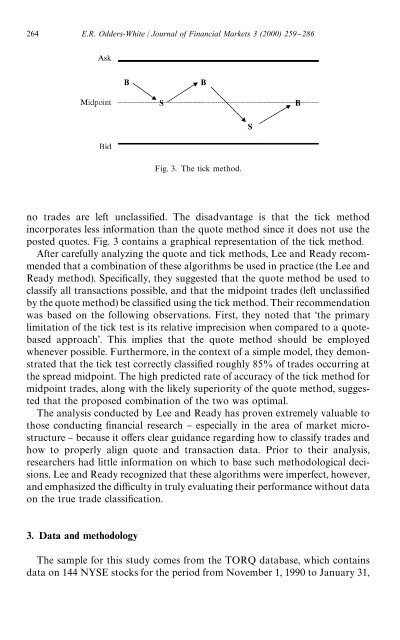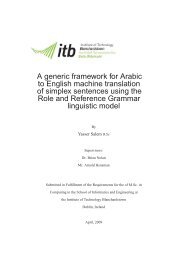On the occurrence and consequences of inaccurate ... - Acsu Buffalo
On the occurrence and consequences of inaccurate ... - Acsu Buffalo
On the occurrence and consequences of inaccurate ... - Acsu Buffalo
You also want an ePaper? Increase the reach of your titles
YUMPU automatically turns print PDFs into web optimized ePapers that Google loves.
264 E.R. Odders-White / Journal <strong>of</strong> Financial Markets 3 (2000) 259}286<br />
Fig. 3. The tick method.<br />
no trades are left unclassi"ed. The disadvantage is that <strong>the</strong> tick method<br />
incorporates less information than <strong>the</strong> quote method since it does not use <strong>the</strong><br />
posted quotes. Fig. 3 contains a graphical representation <strong>of</strong> <strong>the</strong> tick method.<br />
After carefully analyzing <strong>the</strong> quote <strong>and</strong> tick methods, Lee <strong>and</strong> Ready recommended<br />
that a combination <strong>of</strong> <strong>the</strong>se algorithms be used in practice (<strong>the</strong> Lee <strong>and</strong><br />
Ready method). Speci"cally, <strong>the</strong>y suggested that <strong>the</strong> quote method be used to<br />
classify all transactions possible, <strong>and</strong> that <strong>the</strong> midpoint trades (left unclassi"ed<br />
by <strong>the</strong> quote method) be classi"ed using <strong>the</strong> tick method. Their recommendation<br />
was based on <strong>the</strong> following observations. First, <strong>the</strong>y noted that &<strong>the</strong> primary<br />
limitation <strong>of</strong> <strong>the</strong> tick test is its relative imprecision when compared to a quotebased<br />
approach'. This implies that <strong>the</strong> quote method should be employed<br />
whenever possible. Fur<strong>the</strong>rmore, in <strong>the</strong> context <strong>of</strong> a simple model, <strong>the</strong>y demonstrated<br />
that <strong>the</strong> tick test correctly classi"ed roughly 85% <strong>of</strong> trades occurring at<br />
<strong>the</strong> spread midpoint. The high predicted rate <strong>of</strong> accuracy <strong>of</strong> <strong>the</strong> tick method for<br />
midpoint trades, along with <strong>the</strong> likely superiority <strong>of</strong> <strong>the</strong> quote method, suggested<br />
that <strong>the</strong> proposed combination <strong>of</strong> <strong>the</strong> two was optimal.<br />
The analysis conducted by Lee <strong>and</strong> Ready has proven extremely valuable to<br />
those conducting "nancial research } especially in <strong>the</strong> area <strong>of</strong> market microstructure<br />
} because it o!ers clear guidance regarding how to classify trades <strong>and</strong><br />
how to properly align quote <strong>and</strong> transaction data. Prior to <strong>the</strong>ir analysis,<br />
researchers had little information on which to base such methodological decisions.<br />
Lee <strong>and</strong> Ready recognized that <strong>the</strong>se algorithms were imperfect, however,<br />
<strong>and</strong> emphasized <strong>the</strong> di$culty in truly evaluating <strong>the</strong>ir performance without data<br />
on <strong>the</strong> true trade classi"cation.<br />
3. Data <strong>and</strong> methodology<br />
The sample for this study comes from <strong>the</strong> TORQ database, which contains<br />
data on 144 NYSE stocks for <strong>the</strong> period from November 1, 1990 to January 31,
















